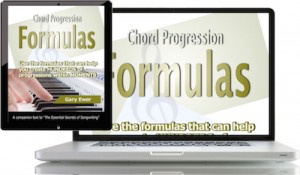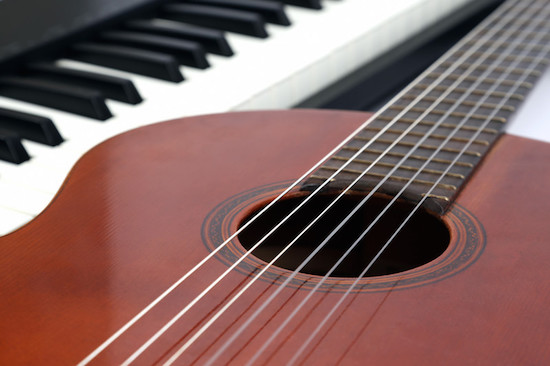Chord choice is one part of songwriting that doesn’t require a lot of imagination. All that’s really required is that a progression works. In that sense, it’s not much different from a piece of country land that you might build a house on. Sure, it may seem important to have land that, on its own, takes your breath away. But if you’re building a house, what’s really important is that it can support the house.
And beyond supporting the house, there are other attributes that make land a nice purchase. It’s nice, for example, if there’s a rolling hill or two, some elegant trees, and maybe a view of the water. Without the house on it, however, a good piece of land can look downright ordinary. Once you place the house on it, the land’s main role is to make the house look wonderful.
 “Chord Progression Formulas” helps you develop chord progressions through the use of some very simple formulas. Purchase it separately, or as part of “The Essential Secrets of Songwriting 10-eBook Bundle.
“Chord Progression Formulas” helps you develop chord progressions through the use of some very simple formulas. Purchase it separately, or as part of “The Essential Secrets of Songwriting 10-eBook Bundle.
In other words, a good piece of land becomes something you don’t notice as much as the house itself. And in that sense, there’s not much different between a good piece of land and a good chord progression. The progression’s main job is to support the other song elements, the melody and lyrics in particular.
But once in a while, it’s nice to create something that’s got more going for it than the fact that it simply works. Sometimes, you want a chord progression that has a bit of freshness, a bit of innovation. The danger in creating chord progressions that are unique is that they can confuse the listener, particularly if the chords aren’t supporting any of the other song components. So how do you create a chord progression that’s a bit more creative than the standard I-IV-V?
Take a look at the following tips and suggestions. It will help your chord creation process if you’re looking to add a bit more variety and innovation to your chords. You won’t necessarily want to do everything in that list, and it should be pointed out that these are not rules. They are simply suggestions for you to try.
- Try starting on a non-tonic chord. A tonic chord is the one that represents your song’s key. So if your song (or song section) is in C major, the C chord is the tonic chord. Most songs will start on the tonic chord. For example, Adele’s “Hello” is in F minor, and the first chord is Fm. But starting on a non-tonic chord veils the sense of tonality, and makes the key a little less obvious, usually in a creative and pleasant way. Lennon & McCartney’s “Happiness is a Warm Gun” starts on a iv7 chord, then moves to the tonic (Am7 – Em), and it adds a lot to the sense of floating tonality to hear throughout the song.
- Try adding 7ths, 9ths, added tones, etc., to standard progressions. Play C – F – G – C, and you’ve got something that lacks any and all uniqueness. But make a few alterations, and you’ve got something that sounds immensely more creative. For example: Cmaj7 – Fadd9 – G11 – C. (Click below to listen)
- Try starting on an inverted chord. An inverted chord is one which uses a note other than the chord’s letter name as a bass note. If you use C in the chord progression, your bassist will automatically play C as the bass note. But starting with C/E or C/G adds a bit of pleasant musical instability to the progression, and can be very enticing to your listeners. Example: C/G – F – C.
- Change key somewhere in the middle of your verse. Jimmy Webb’s hit song “Wichita Lineman” (no. 195 on the Rolling Stone “500 Greatest Songs of All Time,” does this, starting in F major, wandering into D major before wandering back again (and all the while almost completely avoiding the original tonic chord). Frequent key changes are the mainstay of progressive rock, of course. The advantage of changing key quickly and early on is that it prevents your progressions from sounding standard or predictable.
- Try chord substitutions. Sometimes, the best creative progressions are those that start as standard ones, and then, with a few careful substitutions, can take on an entirely new life. So you might take C – F – G7 – C, and turn it into C – Dm – Bb – Am, as long as it still works with your melody. The point is, by starting with a strong progression, then changing chords one by one, you gradually change it into something less predictable, and closer to what you might be looking for.
You’ll find that creative progressions will work better in a verse or bridge than in a chorus. As always, with anything that affects the sound of your song, your ears will be your guide as to what works and what doesn’t.
 Written by Gary Ewer. Follow Gary on Twitter.
Written by Gary Ewer. Follow Gary on Twitter.
 Stop floundering! It’s time to get your songwriting back on track. “The Essential Secrets of Songwriting” eBook Bundle packages will show you how to polish your songwriting technique. The 10-eBook Deluxe Bundle comes with a special deal.
Stop floundering! It’s time to get your songwriting back on track. “The Essential Secrets of Songwriting” eBook Bundle packages will show you how to polish your songwriting technique. The 10-eBook Deluxe Bundle comes with a special deal.











Pingback: Designing More Creative Chord Progressions - The Hit Songwriting Formula | The Hit Songwriting Formula
Great post! I am going through a dry spell when it comes to using imaginative chord progressions. Good ideas here …. some of which I used and had forgotten!
Cheers!
-G